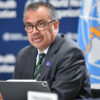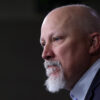Americans’ mental and emotional health can’t be ignored in the fight against COVID-19.
Dr. Elinore McCance-Katz, assistant secretary of the Department of Health and Human Services for mental health and substance use, joins the show to explain the physiological effects of extended isolation.
McCance-Katz is both an epidemiologist and a psychiatrist. That enables her to have a uniquely holistic perspective about the most effective way to protect the whole health of Americans during the pandemic.
We also read your letters to the editor and share the words of President Ronald Reagan on July 4, 1986, as he reminded Americans of where we came from and the importance of unity to maintain our national strength.
Listen to the podcast below or read the lightly edited transcript.
“The Daily Signal Podcast” is available on Ricochet, Apple Podcasts, Pippa, Google Play, and Stitcher. All of our podcasts can be found at DailySignal.com/podcasts. If you like what you hear, please leave a review. You can also leave us a message at 202-608-6205 or write us at letters@dailysignal.com. Enjoy the show!
Virginia Allen: I am joined by Dr. Elinore McCance-Katz, assistant secretary … for mental health and substance use at the Department of Health and Human Services. Dr. McCance-Katz, thank you so much for being here today.
Dr. Elinore McCance-Katz: I’m happy to be here. Thank you for inviting me.
Allen: You are an epidemiologist, but you’re also a psychiatrist, which gives you a very holistic perspective on all the risks of COVID-19, from infection to … social distancing, and [what] those quarantine measures mean for mental health.
Can you tell us a little bit about your background in both the field of epidemiology and psychiatry, and how your education in both of these fields affects your views of how America should respond to COVID-19?
McCance-Katz: Sure. I started out my graduate career at Yale University. I attended the Yale School of Public Health, where I got a Ph.D. in infectious disease epidemiology.
Part of the training that I received at Yale was didactics in epidemiology and the study of viral infections. I do have a background in molecular virology. I have a background in epidemiology as a science and some of the statistical methods to address epidemiological questions.
I wanted a career in clinical research and for many, many years, I have been a clinical researcher prior to coming into federal service, but I decided to go to medical school because I wanted to do research on human pathological conditions and having a medical doctor degree would be helpful with that.
When I went to medical school, I thought I would end up going into infectious diseases, but I became quite interested in psychiatry and in the care and treatment of mental illness and substance use disorders.
COMMENTARY BY
Rachel Greszler is research fellow in economics, budget, and entitlements in the Grover M. Hermann Center for the Federal Budget, of the Institute for Economic Freedom, at The Heritage Foundation. Read her research.
For a second month in a row, the U.S. economy gained a record number of jobs.
Following job gains of 2.7 million in May, the economy added 4.8 million more jobs in June.
And even as the labor force grew by 1.7 million workers, the unemployment rate fell by 2.2 percentage points, from 13.3% to 11.1%.
While unemployment is still high, the faster-than-expected turnaround and record gains show the resiliency of the American economy and prove that this is not another Great Recession.
The American economy just added more jobs in two months than it did in the 46 months after the height of unemployment during the Great Recession.
>>> What’s the best way for America to reopen and return to business? The National Coronavirus Recovery Commission, a project of The Heritage Foundation, assembled America’s top thinkers to figure that out. So far, it has made more than 260 recommendations. Learn more here.
I pursued a career in psychiatry and for many years, I worked at the intersection of HIV disease and addiction medicine, specifically opioid addiction and injection drug use. I spent many years looking at medications development for opioid use disorders.
I also spent many years studying medications that were used to treat HIV disease as well as opioid therapies used to treat opioid use disorder, helping to determine what the best ways were to consider the clinical needs of patients so that they would [have] the best outcomes in being treated for HIV and opioid use disorder if those conditions co-occurred, which is, unfortunately, not an uncommon situation.
At various times, because of the kind of work I was doing, I provided some consultation in state government and, ultimately, ended up in the position I’m in now in federal government.
The issue with coronavirus of course is one that has never been seen before. It’s a new virus. It’s a virus that, because it’s new, we really don’t know its epidemiology. We don’t know a lot of information that is critical to care and treatment of individuals who may become infected, and we don’t know the spectrum of what those infections look like, nor do we have complete data on transmissibility of the virus.
What we did know back in February and March was that we had a viral illness that was quite severe and making many people so sick that they were dying from this illness and, while that is leveling off now, continues to the present time.
With that kind of increase in the numbers of people with infections of becoming so ill, they needed hospitalization and in a time when we had to very quickly learn how to care for people, it was necessary to take the actions that were taken at the level of the federal government from President [Donald] Trump and within the state governments.
That helped to level off the spread of the virus and during that time, we’ve been able to learn a lot about medical care for people.
We’ve been able to get testing much more widely available, and that continues to be an issue that’s worked on every single day at the Department of Health and Human Services. We now have a system that’s being rapidly put in place to do contact tracing.
I mentioned these things because these are really very standard epidemiological approaches to understanding illnesses and particularly infectious diseases that are now up and running in this country, and that puts us in a different place in terms of how we look at things going forward.
The other side of that coin, though, is that for millions of Americans, when we say, “Stay at home, home is safer,” home is not safer for millions of Americans.
There are millions of Americans who suffer domestic violence. There are millions of children who suffered child abuse and neglect. And when our schools are closed and children are at home with their caretakers 24/7, and their caretakers are being asked to homeschool, things they have never been asked to do, this puts vulnerable children at great risk.
We don’t have our usual reporters available. Our teachers, our school staff, our doctors that would be mandated reporters for these kinds of situations, … they simply aren’t seeing those children.
For many people, women and, in some cases, men as well, they are victims of domestic violence and because of stay-at-home orders, they can’t escape. They can’t escape the abuser.
These are very serious issues and there’s a literature … on what the effects of stay-at-home lockdown or quarantine, whatever you’d like to call it, what the effects are on people. What those effects are is that, in as little as nine days, people can develop mental health problems, anxiety, depression, anger.
Anger is one that is mentioned quite frequently, numbing. People experience trauma. Some people will develop post-traumatic stress disorder. And these can be long-lasting conditions.
What we don’t know is what is the effect of having stay-at-home orders or situations where we are prohibiting people from going about their daily activities, which includes, for millions of Americans, job loss and income loss. What are the effects of doing this for two to three months in some places still with no end in sight? The literature actually doesn’t show lockdown that has ever lasted this long, and so we’re quite concerned about that.
Particularly, the agency I lead, the Substance Abuse and Mental Health Services Administration, we are very concerned about the mental health effects on people who are subjected to these very severe policies and who have lost the structure of their lives, the social supports and contacts that keep them going.
We are very concerned about people who have existing mental and substance use disorders who cannot get care because care across the country to a great extent has been canceled, at least the in-person piece of it. Our agency has taken major steps to put telehealth services, telemedicine in place for those needing help with mental and substance use disorders.
This is not something that is familiar to much of our practitioners in behavioral health, and the reason for that is because, as the term implies, behavioral health, we do our work by interacting with people. We want to see our patients. We want to interact with them.
Usually there are symptoms or behaviors or problems, types of responses that people have that we address through individual settings, through group therapies, through therapeutic mill use that for millions of Americans, these are ongoing needs.
They are everyday needs, and they aren’t getting that care. We are very concerned about that. We’re concerned about the links between unemployment and suicide. That’s been documented in the literature as well.
We already know that suicide is one of the 10 leading causes of death in the United States before we ever saw coronavirus. Now, we’re very concerned that there will be an increase in suicide deaths because of the additional stressors that have been placed on our people for months on end and for millions of Americans, that lack of assurance that their job will be there for them when they come back or that they’ll be able to go back to a full-time job.
One of the things I’m hearing from colleagues across the country in my own field is that people’s hours are being cut. They’re being laid off. They’re being furloughed. They’re being asked to use their vacation time to cover reduced salaries that their employer gives them because of the lack of service provision that’s going on in the country right now.
While telemedicine is critically important, it can be lifesaving, it’s a way of making an acute intervention, it’s not going to be ever the full answer. People need that therapeutic interaction that occurs between others that share similar issues and their clinicians that have the experience of years and training and background to help people to address these kinds conditions.
We’re quite concerned about the mental health and substance use disorder fallout from COVID-19, and that’s before thinking about the fact that we have 58 million Americans prior to this virus, 58 million with mental and substance use disorders, many with what we call co-occurring disorders, mental disorders and substance use disorder in the same person.
We know that people who have substance problems usually have problems with more than one substance. We know that people with substance use disorders, only about 10% of them get treatment. That was before coronavirus.
We know that people with mental illness, only about 55% of them get treatment. That’s before coronavirus. We know that 34% of people with serious mental illness, that’s mental illness that is of a severity that people cannot carry out the normal routine daily life functions that the rest of us do because of impairments by their mental illness, 34% of them get no treatment at all. That’s before coronavirus.
We know that since coronavirus has started, appointments and visits have been stopped, that therapeutic intervention, such as intensive outpatient services, partial hospital programs, have been stopped. We know that people are at home bored and stressed, and that alcohol sales have skyrocketed in this country.
We are hearing from the lay press that law enforcement is very reluctant in some states to administer naloxone in an opioid overdose. If you don’t administer naloxone to a person who has overdosed on opioids, they will die, and there’s no need for that. There are safe ways to administer naloxone.
We’re trying to work on that right now, but I mentioned all of these things because what it says is that before coronavirus, we had huge gaps in care and huge needs on the part of Americans for care and treatment of mental health issues and substance problems, which are only being exacerbated by COVID-19.
Allen: Wow, yeah. Weighty. Very, very weighty. Let’s talk for just a second about what actually happens in the human brain. If someone goes weeks or months without meaningful social interaction, whether maybe they’ve already been struggling with anxiety or depression or maybe they weren’t at all before, but now they’re in this place of isolation, are there actually chemical changes that begin to take place in the brain?
McCance-Katz: There are chemical changes that take place in the brain and these chemical changes have been associated with various types of mental illnesses, such as anxiety disorders, such as depressive disorders, such as post-traumatic stress disorders.
Your brain is involved in stress responses and stress responses are mediated by a variety of different types of chemicals in the brain that also travel through the body.
When a person experiences stressors that they cannot address, situations of isolation and anxiety that they cannot change, then those chemicals that stay in balance, which is how all of us go about our daily activities and we are able to manage the normal requirements of our lives because our chemical structures in our brain, are imbalanced. When that changes, that places a person at risk for developing mental disorders.
The thing is that when these imbalances occur, it will take time to rebalance the stress reactions, if you will. When that happens, a person may need medication treatments, they may need psychotherapeutic intervention, a combination of those kinds of interventions. Those resources are how we address these kinds of mental illnesses.
But yes, exactly. This is why I have said that the isolation of the stay-at-home orders are ones that … and again, documented in the literature, in a relatively short amount of time will manifest as symptoms of anxiety, symptoms of depression, angry outbursts, and behaviors that may go along with those kinds of feelings. What lies below that are changes that are occurring in the brain and the rest of the body.
Now, not everybody experiences that. It’s important to really point out that most of us are able to cope with even very severe stressors and the resilience of people.
I think I want to make sure people understand that the majority of people will be able to withstand these stresses, but the people I’m talking about are people who just aren’t able to.
Some of us are more vulnerable than others to mental disorders and substance use disorders. These are genetically mediated illnesses and so for that minority of people, which is a sizable number in the millions, but it’s still relative to our population, a small number of people, those folks are going to need help.
Allen: Yeah.
McCance-Katz: The thing is, we need to get to them before there is a terrible outcome, such as suicide, such as some kind of behavior that harms others, harms themselves, makes it impossible for them to attend to their physical health needs. There are any variety of different ways that these symptoms can make themselves known.
Allen: You spoke with the president and a number of other leaders at the White House in May. What are the recommendations you are offering to national and state leaders right now as it relates to reopening the economy and trying to get life back to some resemblance of normal?
McCance-Katz: What I have said is that we have to think about more than viral infection. We have to think about whole health. We have to think about the needs of a person in their totality. We can’t just think about the possibility of a viral infection. What I have said is that if we fail to do that, we will lose many more lives.
We have so many thousands of deaths, over 116,000 deaths related to suicide and drug overdoses. If you add alcohol into that, some estimates approach 180,000 people a year dying of these very preventable conditions. In addition with COVID, we’ve got a situation where people’s medical problems are not being addressed.
People aren’t getting cancer screenings. They’re not able to see their doctors for existing medical conditions like hypertension, like heart disease, like pulmonary disease, rheumatoid arthritis. There are many serious medical conditions that we must continue to address, and there is no reason not to do that. If we fail to do that, we will have many more deaths than we would see from [the] COVID virus.
Allen: Yeah.
McCance-Katz: What I’ve said is we have to think about whole health, and we have to think about what we’ve learned, and we have learned a lot about this virus. It’s amazing how much we’ve learned in a period of three months.
We have learned how to better manage people who do get so ill with the virus that they have to be hospitalized. We now have [a Food and Drug Administration-approved] treatment for very ill people who have coronavirus infection. We now have increased testing for coronavirus. Greatly, millions of tests have now been completed, and we are setting up a system in this country that will continue to test regularly for high-risk groups.
We have now put in place contact tracing, and we will be following up [with] people to determine who else might have contracted coronavirus when we identify a case.
We now know who the most vulnerable populations are—our elderly, those that are in nursing homes, those that have significant conditions that affect their overall health—and we need to protect them. In doing that, we also need to pay attention to the needs of the general public and the general public needs to go back to regular life, but they need to understand that it’s safe to do that.
I’ve also urged that rather than focusing on deaths that occur from coronavirus—which [the Centers for Disease Control and Prevention] has now said are much less and overall, in terms of the total number of cases, are going to be much less than 1%—we look at the number of people who have had the virus and recover fully, and that number is quite high.
It will be even higher as we do more testing and learn about the great number of people who have had the virus who have had either very mild symptoms or no symptoms.
It’s very important not to spend so much time talking about a virus and emphasizing the negative aspects of illness with that virus that people become paralyzed and can’t go about their lives.
I think that our media has done a great job with that, and that’s not something that I feel good about saying. It’s time to start talking about the progress we’ve made. It’s time to start talking about the fact that almost everyone recovers from this virus and we know who the vulnerable people are, and we can protect them.
If we keep in place good hygiene practices, social distancing, mask-wearing as possible for people to do, then we can get back to normal life, and people should feel confident about that.
We should not shut down again because we know how to deal with this problem. We should send our children to school. They need to be around other children.
They need social interaction, and they need the opportunity to learn, and they need to be with teachers and others who can tell how their health and mental health is, and let us know if those children need help.
It’s really quite important that we stopped talking about COVID as though it’s a death sentence if people get the virus, it is not, and we go back to normal life because we know how to deal with this as a country.
Allen: Wow. Thank you so much. That’s so insightful. And I think your holistic approach is incredibly helpful for perspective.
I want to take just a second and ask you, for those who might be listening and who are thinking, “You know what? I think I am really struggling with depression in this season with anxiety,” and maybe they’re concerned about a loved one and a loved one’s mental health, do you have any practical tips for things that they can do to get their own brain and mind or a loved one’s back to a healthier and better state, so that they can keep living life?
McCance-Katz: Yes, it’s really very important that as much as possible people stay in contact with their loved ones, with their social connections. They can do that by telephone, by social media. It’s important for people really to get outdoors, to get some exercise that can be remarkably soothing and helpful.
To the greatest extent possible, keep a daily routine. It is so difficult for people when they lose their daily structure, as in stay-at-home orders, where your daily activity, get up in the morning, you take a shower, you get dressed, you go to work, you come home, you make dinner, you take care of your family, your pets, and have your evening activities. When that’s taken away, that is so disorienting for people. It really takes a toll.
Even people who are able to telework, it takes a toll on them as well and for people who are completely out of work, it is extremely stressful and very difficult to cope with.
Take care of yourself and if you are feeling extremely sad, if your appetite goes off, if you can’t sleep, if you’re experiencing a very severe anxiety, it’s really important that you seek help, and there are ways to do that.
We have helplines at SAMHSA [the Substance Abuse and Mental Health Services Administration]. We have the Suicide Prevention Lifeline. We have a Disaster Distress Helpline, and we have a National Helpline that helps people to find treatment. They can talk with a person that will help them to find a treatment outlet, a treatment resource near them.
You can also find SAMHSA resources online at findtreatment.gov, … that will help in help for substance problems. All you have to do is put in your city, your state, your ZIP code, and you can find resources in your area.
We also have a way of finding mental health services. It’s called findtreatment.samhsa.gov and again, that is a way to find resources for mental health issues.
It’s important that people take an inventory of how they’re feeling, and if they’re having trouble coping, seek help, seek support from those that care about you. If that isn’t enough, then seek professional help.
Allen: We’ll be sure to link some of those resources in the show notes for today. Dr. McCance-Katz, thank you so much for your insight. It has been incredibly helpful and profound. We really appreciate your time today.
McCance-Katz: Thank you so much.
























